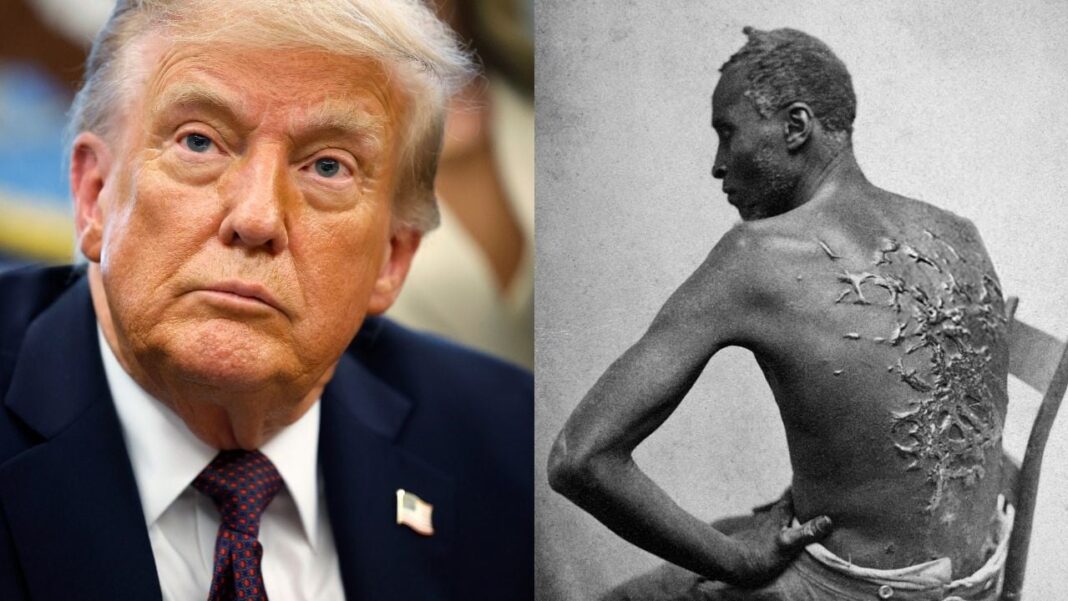The 1863 photograph titled “The Scourged Back” is not just a powerful image; it serves as a stark reminder of the brutal realities of slavery in America. Captured by photographer and abolitionist Augustus Washington, the photograph depicts an escaped enslaved man named Peter, whose bare back is painfully marred by raised scars from repeated whippings. As one of the most haunting images of its time, “The Scourged Back” shocked viewers when it was published during the Civil War, presenting undeniable evidence of the cruelty of slavery and helping to galvanize abolitionist sentiment in the Northern states.
However, over 160 years later, this iconic image may soon vanish from public view in national park exhibits. Reports indicate that recent directives from the Trump administration could lead to its removal along with other artifacts and exhibits that depict slavery and racial trauma as “negative” aspects of American history. This proposed erasure has raised alarms among historians, educators, and advocates for social justice, who see it as an attempt to sanitize a crucial, albeit painful, chapter in the nation’s past.
On September 15, news outlets reported that federal officials were instructed to remove “The Scourged Back” alongside other interpretive signs and materials focused on slavery and racial issues. This directive is the result of Executive Order 14253, signed by President Trump on March 27. The order outlines a broader initiative to “restore truth and sanity to American history” by altering or removing content deemed disparaging to Americans, particularly individuals from colonial times.
The implications of this executive order are staggering. It not only targets singular exhibits but extends to broader narratives concerning slavery, Indigenous history, and even climate change. The National Park Service, responsible for many vital historical sites, has flagged over 30 signs at Harpers Ferry National Historical Park that may violate these new guidelines. These signs often delve into topics like racial discrimination and injustices faced by freed Black individuals, raising the question: What happens when we attempt to erase these difficult truths?
Critics of the administration’s moves argue that ignoring or removing uncomfortable aspects of American history will not make them disappear. Alan Spears, a senior director with the National Parks Conservation Association, articulated this sentiment by stating, “Pretending that the bad stuff never happened is not going to make it go away.” The notion that these disturbing elements of history should not be discussed or displayed trivializes the experiences of those who suffered and undermines the collective understanding needed to unify a diverse society.
Cedric Haynes, the vice president for policy and legislative affairs at the NAACP, further emphasized the necessity of including slavery in the American historical narrative. He remarked that slavery was not merely a side story; rather, it was the driving force behind American economic growth for over two centuries. This perspective urges a profound reconsideration of how we portray historical figures and events in educational contexts.
The efforts to sanitize historical exhibits reach notable locations beyond Harpers Ferry. For instance, the President’s House Site in Philadelphia—where George Washington enslaved individuals during his presidency—has also been identified for review under these new guidelines. Experts like Cindy MacLeod, a former superintendent at Independence National Historical Park, warn that any attempt to extricate slavery from such critical exhibits would fundamentally alter the essence of these historic sites.
Beyond the individual instances of censorship, the broader campaign reflects a disturbing trend to reshape public institutions’ representations of U.S. history. Earlier this year, there were efforts to scrub references to Harriet Tubman and the Fugitive Slave Act from National Park Service materials, further indicating a systematic initiative to diminish the visibility of difficult historical truths.
Historians and educators stress that the stakes associated with these removals extend well beyond individual exhibits or websites. Artifacts like “The Scourged Back” had a specific purpose: they aimed to shock, educate, and provoke discussion about the harsh realities of slavery and the fight for freedom. Removing such significant images risks not just a sanitization of history but also a weakening of the collective memory that shapes the national identity. By confronting our past with honesty and rigor, society stands a better chance at understanding and reconciling with the legacies that continue to shape contemporary life.



